Monsters of /X/ #2
2025-02-15
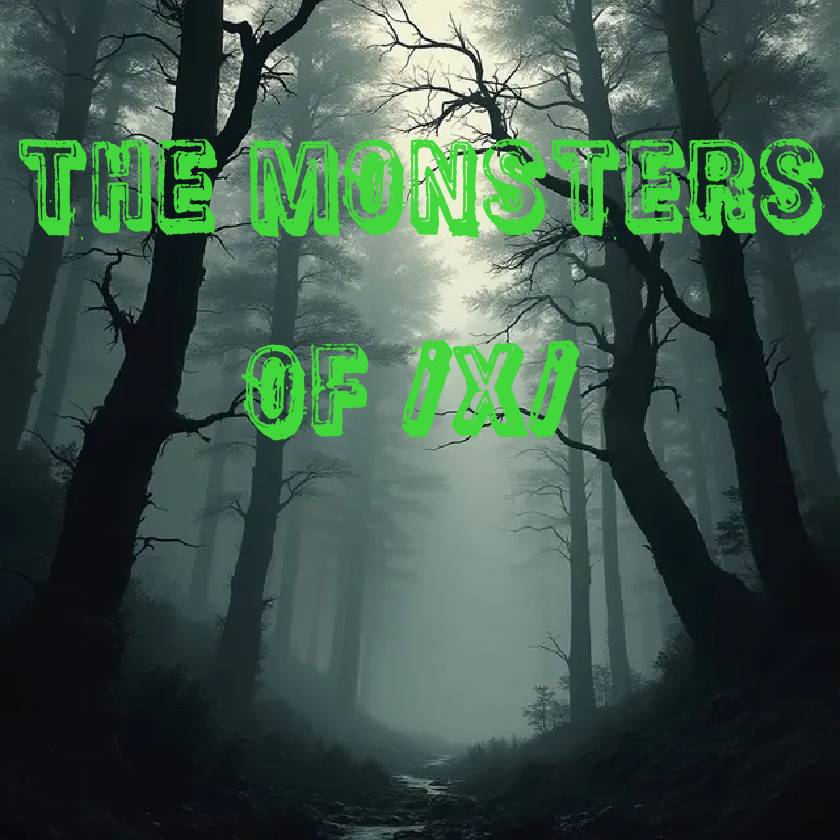
Introduction
I’m not good with introductions, so I’ll get to the point. If you don’t understand the concept of Monsters of /X/, go read my first article here. If you haven’t read my first article and don’t plan on reading it, the basic conceit is that I’m making monster write-ups based on creatures from 4chan’s /X/ board, which is their paranormal and conspiracy board.
Pretty simple—but not as simple as you might think. I had hoped to put this article out a couple of weeks sooner than I did, but I ran into some trouble. The primary issue was motivation, though that’s more of a first hurdle than anything else, as once I get into the research phase, I quickly become enthralled. The second issue, which I mentioned in the first article, is finding the original sources for many of these things.
4chan, as a site, has very poor archival. Finding an old greentext is borderline impossible unless you know exactly what you’re looking for, and even then, it’s troublesome. More often than not, YouTube channels devoted to reading greentexts with automated voices are better sources than the websites dedicated to archival. So, expect a lot of YouTube links…
With that in mind, I’m looking for feedback on these articles. Also, if you have any interesting greentexts either screencapped away or ones you’ve found yourselves and would like to share, please do.
Monster Templates
For Monsters of /X/ articles as well as any non-specific OSR system content. The template is derived from my own ruleset, Be Not Afraid, and includes a few features not commonly found in other OSR systems. Regardless, the stats are easy to convert to any OSR system.
Presumptions of the Statlines
-
Monsters use a single saving throw (a mono-save), which must be rolled over. While this differs from how player characters save in my system, some monsters have specified saves or bonuses against particular effects.
-
XP values and loot tables are not included. My system handles progression in a non-linear fashion, though most OSR systems have straightforward HD-to-XP conversion tables.
-
Damage resistance in my system is represented as a numerical value that reduces incoming damage. This can stack with effects like traditional OSR resistances or immunities to non-magical attacks. However, my system generally avoids (though does not entirely exclude) such blanket defenses.
Hit Dice (HD): Represents the creature’s health and overall power. Humans use d6; most monsters use d8. Smaller or weaker creatures may use d4, while formidable ones may use d10 or d12 (rare).
Armor Class (AC): Measures how hard the creature is to hit and how well its defenses prevent damage. Starts at 9 and increases with higher protection.
Damage Resistance (DR): Reduces or negates damage taken by the number listed. Found in creatures with tough hides, armor, or supernatural resilience.
# of Attacks: The number of attacks a creature can make and the limbs/weapons used.
Attack Bonus (AB): The bonus to hit in combat. Defaults to the creature’s HD (up to +9) unless specified otherwise.
Damage: The damage dealt by each attack, including type if relevant.
Movement: Speed in feet and type (e.g., walking, flying).
Save: A single saving throw for avoiding harmful effects, usually the default DC starting at 16. Special cases may include bonuses for specific effects (e.g., Magic, +2).
Resolve: Morale or willpower to stay in combat. Roll 2d6; if the result equals or exceeds this number, the creature flees or surrenders. Triggered when at half health or after an ally’s death.
# Appearing: How many of the creature are typically encountered, expressed as a die range (e.g., 1d4, 1d8).
Fleshgaits
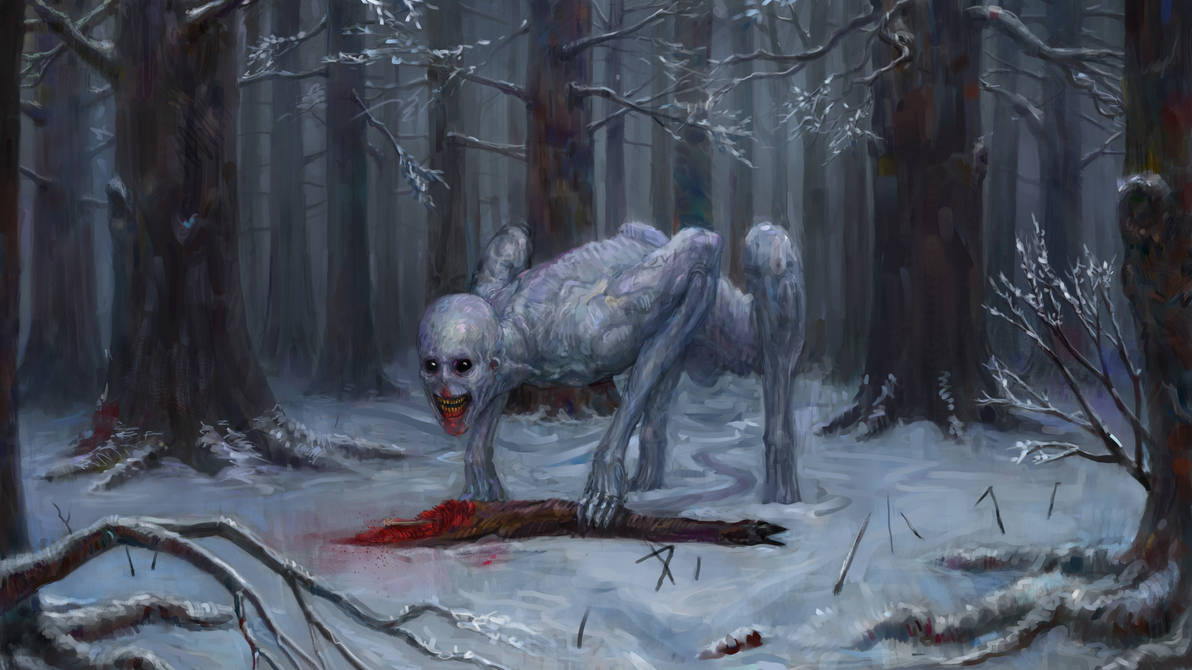
art credit to Váradi Paszkál over on Artstation
Mid December, so snowy af
Stop at walmart, buy another box of tula and a few packs of Newports
See poster hung up near the pisser in the wally world
See girl recently gone missing
Stare at picture for awhile
Think lonely thoughts
- Anon
As mentioned before, 4chan stories often put their own spin on otherwise well-known mythological concepts, and the Fleshgait is a perfect example. Most Fleshgait stories are essentially Skinwalker stories. The name change happened because most of the 4chan “Skinwalker” stories tended to confuse and mix elements from Wendigos and Goatmen, often blending their traits and abilities until the result no longer resembled any of them.
What we got out of this was a reclassification of a fairly old phenomenon on 4chan. Most of the Skinwalker stories on 4chan do not, in fact, represent Yee Naaldlooshii myths as presented in Navajo traditions, nor the Algonquian folklore pertaining to the Wendigo. Where the Fleshgait differs from the former is that, unlike them, the Fleshgait was never human.
To clarify, Skinwalkers are just bad medicine men or witches—people who made dark pacts with the wrong spirits for selfish ends. They are, ultimately, human. Likewise, the Algonquian Wendigo is a spirit that possesses a human who commits cannibalism. But the Fleshgait is an altogether different entity.
So what is a Fleshgait?
Fleshgaits are predatory mimics with a suite of rather oddball abilities and tendencies. First and foremost, they can shapeshift—though seemingly, this requires them to kill or eat a victim before they can take on their form. However, this isn’t a universal restriction in all stories. Likewise, they can repeat and copy any voice they have heard, but this is primarily limited to exact phrases or things they’ve already heard before, meaning they can only parrot voices. That said, this limitation doesn’t stop them from being unnervingly creative. Often, this ability is paired with uncanny ventriloquism, allowing them to throw their voices and make it unclear where exactly the sound is coming from, though this is a rarer trait.
Their true form is a bit inconsistent in description, though it is often depicted as a tall, pale, emaciated humanoid with unnerving proportions. Despite their seemingly brittle and famished appearance, they are freakishly strong and fast compared to humans. Often sporting clawed digits and fangs, these things can turn you into brisket pretty quickly.
The scariest trait they have is their minor glamour ability. It’s subtle, but when combined with their other abilities, it seals the whole package together. What do I mean by minor glamour? Well, in a lot of stories, they seem to have a projected aura effect that prevents people from picking them out concretely in a small crowd. They just sort of show up at a campsite disguised as someone else, and nobody really questions it—victims’ minds automatically assume someone among them invited this stranger, whose name is just on the tip of their tongue…
This effect seems to weaken in inverse proportion to the size of the crowd. Smaller groups—one or two people—tend not to be fooled by this trick, while groups of seven or eight can be susceptible. A group of twelve or more is probably very susceptible.
Despite all this, their durability seems to be lacking compared to other spooks. Plenty of 4chan stories feature the anonymous protagonist doing serious harm to these things, with anything from .308 Winchester to 7.62×54mmR having a notable effect on target.
That, and they have a very bad tell—a corny trope common in /X/ stories—which is that they smell like absolute ass. A heavy, coppery blood odor gives them away well before they’re seen.
-Fleshgait-
Hit Dice: 5
Armor Class: 16
# of Attacks: 3
Damage: 1d6+3 claws, 1d4+4 bite
Movement: 50 ft. (on foot) 30 ft. (climbing)
Save: 10
Resolve: 8
# Appearing: 1d2
- Special Abilities -
-
Shapeshift: The Fleshgait can perfectly shapechange into any victim it has killed or eaten, this transformation takes 1d6+1 rounds to comeplete, perfectly mimcing the apperance of a victim. the shapeshift cannot however mimic tattoos, piercings, or clothing. if the transformation is rushed or interuppted in anyway the shapeshift is uncannoy and noticable.
-
Voice Copy: The Fleshgait can replay any voice or sound it has heard perfectly, repeating anything from full sentences to car alarms or even ambiant noises, it cannot however say anything it hasn’t already heard someone say.
-
Minor Glamour: The Fleshgait produces a glamor effect that makes it harder to notice in groups when it is shapeshifted. groups of 4, the Fleshgait is noticed on 1-2 out 6 chance, groups of 6 or more the fleshgait is noticed on a 1-2 out of 8, and in groups of 12 chance or more the fleshgait is noticed on 1-2 out of 12 chance.
Behaviour & Tactics
The Fleshgait is rather odd in many respects. Despite seemingly preferring remote areas away from humanity as a whole, it appears highly specialized in hunting and mimicking humans. Many of its tricks don’t seem like the kind that would work against large apex predators like big cats or bears. This leads me to suspect that they don’t live as far out as we might imagine but instead prefer to exist on the periphery of the human world—large national parks, hiking trails, and more remote camping destinations. These are places that are altogether secluded but not entirely devoid of human presence.
This aligns well with the nature of the Missing 411 cases and the startling number of people who go missing in these places. I’m not saying the Fleshgait is responsible for the majority—or even a fraction—of those cases, but their victims could easily be lost in the statistical white noise, given the staggering number of people who disappear regardless.
This leads to an interesting implication regarding the Fleshgait: their population must be pretty small. While that might seem like a given for most supernatural creatures (hence why the general human population isn’t aware of them), in the Fleshgait’s case, it must be exceptionally small—even by that standard. This lines up with many of the stories. Almost never are more than two spotted together, implying they are quite territorial and only ever hunt together if they are a mating pair—and probably only for the duration of the pregnancy, if that.
This makes a lot of sense, given that their preferred prey is humans. Humans are quite dangerous game, and we tend to come down hard on predators that encroach into our areas. As a result, these things likely have vast hunting territories and don’t stay in any one place for long, giving each other wide berths. This could explain the sparseness of their population—it’s quite possible that many different Fleshgait stories are actually describing the same individual, especially if the events occurred within a 50- to 100-mile radius of one another.
However, I should mention a startling exception to this rule: the urban Fleshgait. Stories about this variant are much rarer, but the ones that exist describe some disturbing adaptations. Urban Fleshgaits tend to prefer condemned housing or abandoned apartment blocks—places unlikely to be disturbed by humans for long periods. Often, when their dens are discovered, the remains of pet collars and smaller bones litter the area, suggesting that the urban variant subsists less on humans and more on small pets and critters like cats or raccoons. This doesn’t mean they’re any less dangerous, but they’re less likely to go after humans unless they can guarantee a clean kill. This is in stark contrast to their wilderness counterparts, which tend to be much bolder and more aggressive. The last thing an urban Fleshgait wants to do is draw attention to itself—unlike its wilderness brethren, it can’t just slink off into the woods if things go south.
This leads me to a disturbing implication: what if the urban variant is actually the more common species? Given that their glamour effect improves in direct proportion to the size of the group they’re hiding in, it’s entirely possible that you could pass them on the street every day and never notice them.
As for how I’d run this creature at my table? While I’m not a fan of withholding information or gaslighting players—I find that kind of thing to be cheap when it comes to suspense or tension— but one of the most effective tricks I’ve seen was in a game I watched. The DM introduced an NPC off the cuff a good couple of minutes after everyone in the scene had already been established, casually remarking that “someone must have invited them.” Somehow, this worked. It was incredibly funny and really sold the glamour aspect of the monster’s abilities.
Beyond that, the Fleshgait isn’t all that special compared to other ambush monsters. I wouldn’t consider it any more dangerous than a big cat—except for all the tricks it uses leading up to the ambush.
Greentexts
-
A fleshgait classic and one of my personal favorites also the OG greetext version
-
Another classic where a /k/ommando goes apeshit and beats a skinwalker/fleshgait
Not-Deer
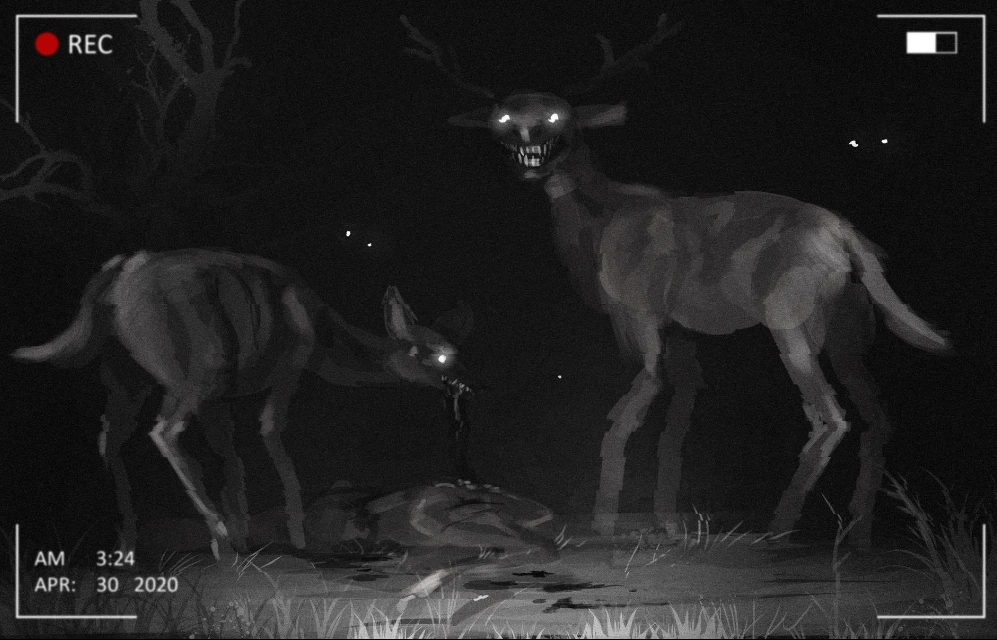
art credit to Lisa Steinberg on twitter/X
In the middle of the clearing a group of five stags were huddled together. Their heads were bowed down, as if they were grazing. We noticed they all make sudden, violent jerking motions, like they were trying to gore the ground with their antlers. Pietr fired a shot into the air, trying to make them scatter. They don’t fucking move.
Pietr gestures to the ground infront of the stags. To our collective bewilderment, there was large adult brown bear. It was in a stage of decomposition, which meant it had been dead for at least four to five days. The stags were panting and groaning as they continualsy gored the carcass over and over again.
- Ranger Anon
Like the Gorp mentioned in the prior issue of Monsters of /X/, the Not-Deer are a type of creature with a plausibly real existence in our own world—the primary world, as Tolkien might put it. That said, interpretations of these creatures run the spectrum from scientifically plausible to a downright supernatural horror show and everything in between.
So let’s describe the baseline of what a Not-Deer is. Not-Deer are (or appear to be) deer of any type, really, but they have undergone a radical behavioral shift from timid herbivores to bold, aggressive, pack-hunting carnivores with a cannibalistic streak. Often, stories involving these creatures feature the protagonist as a hiker or park ranger stumbling across a herd—or rather, a pack—of these things after they’ve made a fresh kill, much to the protagonist’s horror.
One of the first instances of this phenomenon came from a story featuring a Russian park ranger, Anon, who stumbled across a destroyed campsite and the remains of several young men who had been gored to death. Later in that same story, they encountered a pack of these creatures feasting on a dead bear. They seemingly fear nothing, not even flinching at gunfire when shot at—a highly abnormal trait for deer, as almost any loud noise typically sends them running.
As for explanations for these creatures, the most common and generally accepted theory is that they are a form of contagion—specifically, chronic wasting disease (CWD). CWD is particularly interesting because it’s not a typical viral or bacterial infection. Instead, it is caused by misfolded proteins known as prions. In layman’s terms, these prions act like genetic or metabolic tumbleweeds, wreaking havoc inside the affected organism and essentially decomposing it from the inside out—hence why it’s sometimes called “zombie deer disease.” However, what makes Not-Deer different is that deer infected with CWD do not become aggressive; in fact, they tend to become more passive and disoriented. While this behavior can be dangerous in its own way, it does not align with the traits of Not-Deer. Perhaps Not-Deer are the result of a very specific, rare strain of chronic wasting disease?
Another contrast between CWD and Not-Deer is their seeming durability—or, at least, the durability described in most Not-Deer stories. These creatures can be heavily dismembered and injured before finally going down. While chronic wasting disease may make deer appear zombie-like, it does not grant them the ability to shrug off wounds that would normally be fatal. Some of this resilience could be explained by neurological damage affecting pain perception, but many of the described injuries in these tales defy conventional explanation.
So what else could be behind the existence of Not-Deer? Another common theory is that they are some form of aggressive branch species. Many accounts describe them as having double-jointed limbs, front-facing eyes like a predator (as opposed to the usual placement on the sides of their heads), or even—on rare occasions—extra eyes. These are physical mutations that a prion-based disease simply wouldn’t cause.
Perhaps, instead of a new subspecies, Not-Deer represent a physical alteration occurring within existing deer populations. However, rather than being the result of a prion disease, their origins might lie in genetic engineering—possibly tied to a conspiracy, a rogue scientist, or an act of ecological terrorism. Another possibility is that Not-Deer are the creation of some kind of malevolent genius loci—a spirit of the land—lashing out at humanity in response to environmental destruction, manifesting these creatures as a kind of monstrous antibody response against human encroachment.
-Not-Deer-
Hit Dice: 3
Armor Class: 12
# of Attacks: 2
Damage: 1d8+3 Antlers,1d6+2 Hooves, 1d4+2 Bite,
Movement: 50 ft.
Save: 14
Resolve: 12 (Never runs or flees)
# Appearing: 2d4+2
- Special Abilities -
-
Disgustingly Tough: When dropped to 0 HP, the Not-Deer rolls a d6, on 1-2 they get back up with 1 hp, each time this happens increase the die size, e.g d8 > d10 > d12.
-
(Optional) Double Jointed: When maing a save to not be entangled or tied-up, the Not-Deer makes it at +4
Behaviour & Tactics
Despite how simple they may seem and how their aggression might suggest straightforward encounters, that isn’t entirely the case—at least, not according to the original Russian story. Not-Deer possess a crafty and uncanny intellect. One of the prime examples of this is an instance where six to eight Not-Deer slowly surrounded two hunters in a deer blind, creeping closer from all sides in an apparent attempt to ambush them. There are many accounts of similar behavior, whether as a tactical choice or seemingly just to toy with their victims.
Outside of direct encounters, their behavior would largely depend on what you believe them to be. If they are simply a particularly nasty strain of chronic wasting disease, then they are effectively zombies in the form of deer. While that could be interesting, it might also feel a bit one-note, so I won’t expand on that angle here.
The real hook—or selling point—of Not-Deer is the sheer WTF factor of encountering them. Imagine a group of players stumbling upon a “herd” of these creatures, only to realize they are feasting on one of their own or something else entirely—ripping it apart in a grotesque frenzy. Then, as the players watch in horror, the Not-Deer slowly turn their attention toward them.
Greentexts
The Olgoi
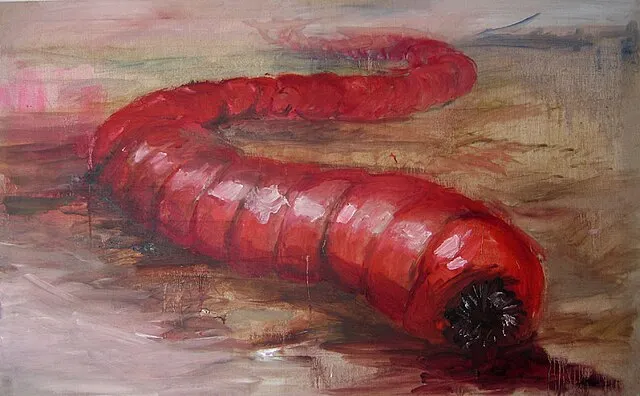
Art credit to Pieter Dirkx
A gigantic worm, almost as big as a cow, it was a reddish color and had a large hole in front of it showing off layers and layers of shapr small white teeth. This thing didn’t seem to have eyes but it surely knew somehow I was there. Because as soon as it got in front of me, it lifted part of its body and became almost my own height.
- Anon
The Olgoi, Olgoi-Khorkhoi, or simply the Mongolian Death Worm, is a legendary creature from Mongolian folklore. According to the original tales, it was said to be only about two feet long, yet deadly to the touch due to its extreme toxicity—like some mix of a poison dart frog and a venomous snake. Supposedly, it was confined to the Gobi Desert, where it stalked travelers.
Despite this, the 4chan version of the creature shares only its general appearance and form; its abilities and size, however, are entirely different. The story featuring this version of the Olgoi likely didn’t even take place in the Gobi Desert, yet it still retains the name from the Mongolian myth.
The 4chan variant is more akin to something like the Chupacabra—it’s a cattle mutilator, lurking around ranches and farms, picking off cattle and chickens unlucky enough to cross its path. However, it is much larger than its folkloric counterpart, with a diameter nearly as wide as a cow and a length twice as long. What’s particularly surprising is its speed—it can keep pace with a human in full sprint, an impressive feat for a creature of its size and one that has no limbs.
-The Olgoi-
Hit Dice: 4
Armor Class: 14
Damage Resistance: 4
# of Attacks: 1 + grapple
Damage: 2d6+2 Bite,
Movement: 30 ft. (on land) 20 ft (tunneling)
Save: 12
Resolve: 10
# Appearing: 1
- Special Abilities -
-
Grapple Bite When struck if the creature is the same size or smaller it must make a Reflex Save (Vs. Paralysis) or be grappled, while grapped the Olgoi does an extra 1d6 damage per turn and the creature cannot move. every round there after the creature can make a Fortiude Save (Vs. Death) to free themselves.
-
Sound Sensitivity: The Olgoi can sense sound in a 200 ft. radius around it, knowing the precise location of where the sound was made. The Olgoi will always focus on the loudest sound made and check there first.
-
(Optional) Death Touch: The Olgoi exterior is laced with an supernaturally deadly neurotoxin, any creature that comes in physical contact with it must make a Fortiude Save (Vs. Death) or instantly die.
Behaviour & Tactics
I included the last optional ability in case you wanted to make it more in line with the Mongolian version of the story, though it does make this creature extremely deadly in melee combat. As for what happens when a character successfully saves against its death touch—well, that depends on whether the effect is supernatural or natural. If supernatural, the character may simply be immune for some unknown reason. If biological, they could have a natural immunity, or perhaps they suffer a delayed reaction, becoming violently ill later.
To understand how this creature hunts, we need to consider its speed. Cows are surprisingly fast—when motivated or frightened, an average cow can reach speeds of up to 25 mph. By comparison, the fastest human on Earth, Usain Bolt, has been clocked at 23 mph. This is important because the Olgoi can only just keep up with a sprinting human, yet its primary prey consists of cattle. This suggests it is an ambush predator rather than a pursuit predator. Given that it’s a large sand worm capable of tunneling and is highly sensitive to sound, this makes perfect sense.
It likely waits in ambush beneath the sand, then bursts out to instantly tear the throat out of any cattle that pass over it before dragging the carcass away to eat in peace. Nothing too unusual there. However, what is interesting is its extreme territorial aggression. In the primary greentext story featuring the creature, it abandoned a fresh kill mid-feast to chase a child all the way back to a ranch. It then proceeded to kill two dogs and even break into a house. Once agitated, it does not give up the chase easily—despite its biology suggesting it shouldn’t be suited for prolonged pursuit or such high levels of aggression.
Its ecological niche somewhat contradicts its temperament. It appears to have a short fuse and an almost obsessive drive to kill anything that disturbs it. Yet, despite this, the Anon from the story never saw it again after the incident. Perhaps these creatures have large hunting territories and simply move on after exhausting an area. Alternatively, they could have an extremely slow metabolic process, only emerging to feed once every few months, spending most of their existence in a sedentary state except for rare bursts of violent energy.
That said, there isn’t much that makes the Olgoi particularly special compared to creatures like Dungeons & Dragons’ Purple Worms or the Dholes from Lovecraftian mythos. Nor does it come close to something as significant or powerful as Shai-Hulud from Dune.
Greentexts
The Horror
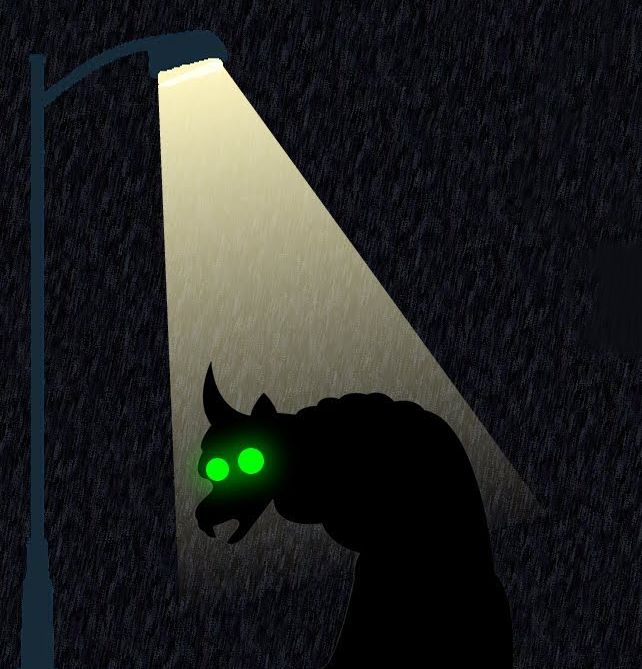
Art credit to Keque over on Youtube
as soon as the rain passed josh came to my house. according to him there was a huge creature on top of the roof. looking out with huge green eyes which looked like two illuminated headlights. it was a totally surreal creature it looked like a huge bat or a gargoyle. it was all black like a shadow it was about eight feet tall and whatever it was it had huge wings similar to a bat’s wings with a little horn on the central tip of the wing. the creature also has small horns and was crouched down sitting like a dog and had three fingers in each of its claws the creature then looked at him and. stared at him for a few seconds before shrieking and flying into the night he said that when he flew it was like it had strips of cloth or something hanging from its body.
- Security Anon
One of the issues I often encounter when writing about these monsters is that there is either too much information to go on or not enough. In either case, a great deal of extrapolation is usually required. The Horror falls into the latter category—there simply isn’t much material available. To my knowledge, it has only appeared in a single greentext, though given the state of greentext archival, I can’t say that with absolute certainty.
Despite its brief appearance, The Horror left a strong impression on me. Many 4chan monsters tend to fall into two broad categories: predatory creatures that, while strange, remain somewhat plausible (if you ignore the more supernatural elements), or fully-fledged spirits from the vasty deep.
The first and foremost detail worth mentioning is that The Horror is a tangible entity, despite exhibiting traits more commonly associated with spirits. In the story, the Anon security guard manages to trap it in a hallway, and the creature appears unable to escape until a window is opened—at which point it simply flies away. It has wings, but seemingly without function, as its method of flight is described more like hovering, akin to how a ghost moves rather than an actual flapping motion.
Of course, its most striking feature is its eyes. This is arguably the most supernatural aspect of the creature. Anyone who gazes into its glowing green orbs is afflicted with a form of psychic ailment. The effects progress in distinct stages: first, an immediate and overwhelming sense of terror washes over the victim. In the following days, they experience memory loss and unexplained gaps in perception. Eventually, this deteriorates into full-blown chronic schizophrenia.
-The Horror-
Hit Dice: 6
Armor Class: 16
# of Attacks: special
Movement: 30 ft. (on land) 60 ft (flying)
Save: 9
Resolve: 8
# Appearing: 1
- Special Abilities -
Gaze of the Horror : Any creature that looks directly into its eyes must immediately make a Will Save ( vs. Spells) or fall under its influence. The effect unfolds in stages, at set time intervels saves must be made, failed saving throw causes the victim to experience next of the following stages:
Stage 1: Upon failing the first save, the victim is struck with intense fear and must flee from the Horror 1d4+1 rounds, as well the victim begins hearing faint whispers that seem to call their name. The whispers grow louder and more frantic as time passes. The victim suffers a -2 to all reaction rolls or INT, WIS, or CHA based checks for the follow 24 hours.
Stage 2: Next Save: After the first 24 hours the victim makes another save, on a failed save, the paranoia sets in. The whispers escalate into incoherent, maddening voices. The victim has -4 on all reaction rolls and takes a -2 INT, WIS CHA checks, as well 1-3 of 6 chance of getting proper sleep each night, 4-6 the victim are restless and restore no HP.
Stage 3: Next Save: after 1 week later the victim makes another save, on a failed save memory loss sets in. They forget simple tasks, where they put things, and even names of close friends and family. The victim can no longer recall any details of their daily routine without assistance. This affects their ability to perform routine tasks without help. This causes a -4 penalty all Reaction rolls, and to all INT, WIS, and CHA based checks. they must also roll a d6 every 24 hours. On a roll of 1-2, they forget something crucial—like their name, their current location, or their current objective.
Stage 4: Final Save: the victim makes a final save one week after stage 3. If the victim fails their final saving throw, they experience a complete psychotic break. They are driven mad, becoming paranoid and untrustworthy to everyone around them. At this stage, they are effectively NPCs, acting unpredictably. The victim becomes an insane NPC, and they may either become catatonic or start acting in increasingly erratic ways, such as attacking allies, hiding from imaginary threats, or becoming obsessed with unimportant objects.
Behaviour & Tactics
Based on its behavior and primary ability—its Gaze Attack—The Horror seems less like a conventional predator and more like a psychic parasite or mind feeder. It never engages in physical conflict, which suggests that it relies entirely on its gaze to hunt and sustain itself. As the Anon of the story theorized, The Horror is a creature that feeds on memory and consciousness, drawing sustenance from the mental energy of its victims. Once it locks eyes with someone, it establishes a psychic link, using that connection to slowly drain their mind over time.
From a hunting behavior standpoint, The Horror likely doesn’t hunt often—perhaps only once every few years or even decades. It may wait for its previous victims to live out their lives, continually siphoning from them until they die. Only when its last batch of victims is gone does it emerge once more to claim new hosts to feed upon.
While its ability is incredibly dangerous, The Horror is something of a one-trick pony. It likely avoids physical confrontation at all costs, knowing that it is not well-suited for direct combat. In a D&D setting where magic exists, spells or items like Mind Blank or a Ring of Mind Shielding could render it completely harmless—though the real challenge would be anticipating its attack before it happens.
Finally, one crucial gameplay element to consider: killing The Horror immediately frees all its current victims. Their memories are restored, and their minds are cleansed of its influence. This adds a ticking clock element—if a party member is afflicted, the group must track and slay The Horror before their condition worsens. It also ensures that players who succumb to the final stages aren’t permanently removed from the game, but still emphasizes the urgency of stopping the creature before it’s too late.
Greentexts
Tomtenissar
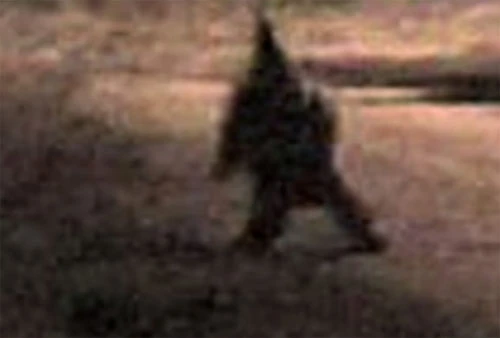
a supposed screenshot from a gnome sighting video 16 years ago in Argentina.
“it wasn’t wise to insult the neighbors.” “there are other people out here I thought you lived alone alone?” “No I just don’t live by people” he replied. “who are your neighbors?” I asked “thought I already told you, the Tomtenissar live here” I didn’t really have a good response to that…
- Anon
Gnomes… Every culture seems to have them. But despite what your grandma’s garden might suggest, gnomes are not friendly little woodland folk baking cookies in trees. No! The English lied to us. The Slavic and Scandinavian people knew better—they warned us about these pint-sized Unseelie bastards. And 4chan, in its endless pursuit of esoteric horror, knew better too.
The existence of malicious, unsettling gnomes is a well-documented phenomenon on 4chan, with dozens of sub-variants. For now, we’re focusing on one particular type: the Tomtenissar.
The primary story featuring them takes place in the northern Yukon during winter. The Anon recounting the tale was young at the time, visiting his grandfather (Dana) to learn about his cultural heritage and spend time with him in the wilderness. However, things take a dark turn when Anon realizes he is being watched.
Unseen gnomish creatures are spying on him from the woods. His grandfather, Dana, has already taken precautions—he has set up warding posts and barbed wire fences to keep the Tomtenissar out. Unlike some horror stories where ignorance leads to disaster, Dana knows exactly what he’s dealing with. His attitude toward the gnomes is like that of an old, grumpy neighbor—he doesn’t like them, but he acknowledges their presence and respects their boundaries. He even leaves offerings for them—animal heads from their hunts, placed just beyond the perimeter as a gesture of respect.
But Anon, being young and unaware of how serious the situation is, makes a grave mistake. He hears whispering voices—soft, demonic, gnomish whispers creeping through the trees. Rather than ignoring them or following his grandfather’s example, he tells them to bug off.
Big mistake. Gnomes suffer no insults.
The situation escalates fast. The Tomtenissar go from distant, shadowy watchers to active aggressors, their unseen presence turning into something far more immediate and malevolent. Soon, Anon and Dana are driven from their cabin, forced to flee back to civilization as the Tomtenissar make it clear that they are no longer welcome in the woods.
-Tomtenissar-
Hit Dice: 1
Armor Class: 13
# of Attacks: 2
Damage: 1d4
Movement: 50 ft. (walking) 40 ft (climbing)
Save: 8 (+4 Vs. Magic, -4 Vs. entanglement)
Resolve: 11
# Appearing: 4d6
- Special Abilities -
-
Group Strength: For every additional Tomtenissar beyond the first in a 30’ radius, add +1 to all damage rolls (maximum +5).
-
Woodland Affinity: Can animate trees and vegetation within 60’, causing them to attack (as per 1 HD monster) or block passage.
-
Shadow Slinking: Can become nearly invisible in shadows or darkness. surprising on 1-4 on d6. attacks made against them are at -4 penality.
-
Whispering Madness: The Tomtenissar can project their whispers 60’, using this as a paranoia and fear tactic.
-
Snow Stride: The Tomtenissar can move on snowy and icy ground as though it was normal terrain.
Behaviour & Tactics
First and foremost, despite how sinister and malevolent they are, the Tomtenissar do not attack unless provoked. Granted, it takes very little to provoke them, and they often try to tempt people into making that mistake. But they never throw the first punch. Like all fairy folk, they play by rules—ones they seemingly cannot break. They adhere to certain unspoken laws, particularly those of hospitality, and will generally keep to themselves if treated with respect and given proper offerings.
However, the moment that neighborly pretense is broken, all bets are off. These creatures become outright murderous, and stopping them is no easy feat. There are only a few reliable deterrents, the most effective being wards—certain Scandinavian sigils and runes seem to repel them, possibly due to some ancient pact or latent magic. Fire is another strong deterrent. Not because they can’t operate in daylight (they can), but because they seem to fear fire itself rather than light.
It’s also likely that other traditional fairy weaknesses apply to them. Iron weapons or objects may be especially effective, as suggested by Dana’s barbed wire fence, which kept them out of his yard.
Interestingly, /x/ and 4chan, at least in this particular story, didn’t take many liberties with how they depicted these creatures. The Tomtenissar—or gnomes in general—are already deeply ingrained in folklore as malicious entities, and 4chan, with its unusual fixation on gnomes, seems to understand their true nature better than most. These aren’t harmless garden decorations or cookie-making elves. They’re something far older, far darker, and not to be underestimated.